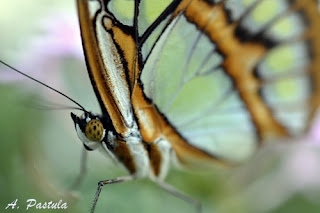This year the winter in both Poland and Germany is really unusual with pretty high temperatures. Unfortunately for the Christmas there was no snow and the weather was rather like usually for the Easter. In Leżajsk there was a sunny day with temperature 4-9°C. During jogging in a forest I have seen some orange organisms on the decaying wood. This could be either fungi or Myxomycota.
Sunday, December 27, 2015
Sunday, December 20, 2015
Tropical bufferflies, Botanical Garden Munich, Germany, December 2015
The colourful tropical butterflies arrived to the Botanical Garden in Munich. Butterflies are amazingly beautiful, although usually they do not live long. Butterflies exist on all continets besides Anatarctica. In the life cycle of a buffterfly there are four stages:
1) eggs -> 2) larva (catepillar) -> 3) pupa (chrysalis) -> 4) adult (imago).
Siproeta stelenes from Middle and northern South America.
You can find him e.g. in the Amazon and Andes.
Monarch (Danaus plexippus), range: North & South America, southern Canada, Australia, Pacific Islands. Every year monarch butterflies migrate extremely long distances (up to 3,000 miles = 4,828 kilometers), because of the cold weather.
Monarch (Danaus plexippus), range: North & South America, southern Canada, Australia, Pacific Islands. Every year monarch butterflies migrate extremely long distances (up to 3,000 miles = 4,828 kilometers), because of the cold weather.
Anteos clorinde is flying in South America, Central America, and North America.
Tithorea harmonia, range: Central & northern South America.
... and this is me ;)
Sunday, December 6, 2015
Who stole winter? (6th December 2015, Munich, Germany)
Although the
first snow appeared in Munich ~2 weeks ago; today there was a beautiful and
sunny day (temperature 3/13 °C), with no signs of winter. Both the squirrels
and the birds were very active today, and they were enjoying the sun ;)
Some interesting
facts about squirrels:
- The most common squirrel in central Europe is the red squirrel (Sciurus vulgaris).
- The red squirrel changes its fur twice a year (with the exception of ear tufts and the tail where the hair is changed only once a year).
- The red squirrels can swim.
- In Ireland, Scotland, England and Italy the eastern grey squirrel (Sciurus carolinensis), that is naturally occurring in North America, was introduced.
- The grey squirrel is larger than the red squirrel.
- The grey squirrel competes with the red squirrel and as a consequence the native squirrels are endangered.
- Have you ever seen white squirrels? White squirrels are a result of genetic aberrations and we can distinguish an albino squirrel (with red eyes) and a white morph.
- There is an UT´s (University of Texas) legend saying that seeing a white squirrel on the day of exam will bring you luck ;)
The Red Squirrel (Sciurus vulgaris)
Sunday, November 22, 2015
Saturday, October 31, 2015
Monday, October 5, 2015
The Moreton Island, Australia, 2015
Bottlenose dolphin
For the first time I was watching wild bottlenose dolphins Emotikon smile, which was one of the most exciting moments in my life! Emotikon wink The dolphins visit Tangalooma in the evenings. At the Moreton Bay there are approximately 600 dolphins.
Wedding bush (Ricinocarpos pinifolius)
Thursday, October 1, 2015
Sunshine Coast, Australia, 2015
Swift-footed crab
That was so cute and lovely purple swift-footed crab Emotikon wink I was lucky to have a possibility to observe him when he was eating algae! Emotikon smile He was so shy and I had to be very careful while photographing him.
Monday, September 28, 2015
Australia 2015
Koalas are very
cute animals that belong to Marsupials (koalas are not bears!!!), and are
native to eastern and southeastern Australia. Koalas eat eucalyptus leaves and the
leaves of gum trees. Koalas love sleeping ;) They sleep
~20-22h per day; this is associated with low-calorie food and the fact that
eucalyptus contains toxins that koalas are neutralizing (they have very long
caecum). Some other animals that sleep long are e.g. brown bat (~20 h/day), three-toed
sloth (15 – 20h/d), North American opossum (~18h/d), and python (~18h/d). In stark
contrast, giraffes sleep only ~2h per day!!!
Koala
Golden Wallaby

Subscribe to:
Comments (Atom)




















































